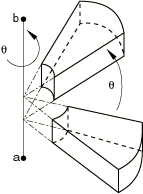*IMPORT | |||||||
|
| ||||||
ProductsAbaqus/StandardAbaqus/Explicit
TypeModel data
LevelPart instance
Required parameters
- UPDATE
-
Set UPDATE=NO to continue the analysis without resetting the reference configuration.
Set UPDATE=YES to continue the analysis by resetting the reference configuration to be the imported configuration. In this case displacement and strain values are calculated from the new reference configuration.
Required parameters if the imported elements are to be renamed (not applicable for import of part instances)
- EOFFSET
-
Set this parameter equal to an integer that specifies the offset to be used to renumber the imported elements.
- NOFFSET
-
Set this parameter equal to an integer that specifies the offset to be used to renumber the imported nodes.
- RENAME
-
Include this parameter to specify new labels for the element sets to be imported from the previous analysis.
Required parameter if importing from multiple previous analyses (Abaqus/Explicit only; not applicable for import of part instances); optional parameter if importing from a single analysis
- LIBRARY
-
Set this parameter equal to a value that specifies the previous analysis from which to import the element sets. You can specify the name of the previous analysis or the name including a full path. If no path is specified, all input files and results files from the previous analyses must reside in the current (working) directory.
When importing from a single previous analysis, if the LIBRARY parameter is omitted, you must specify the job name of the previous analysis in the command line using the oldjob option (see ). If both methods are used, the LIBRARY parameter takes precedence over the command line specification.
When importing from multiple previous analyses, set this parameter equal to the job name. You should not use the oldjob option on the command line.
Optional, mutually exclusive parameters
- INCREMENT
-
When importing an analysis from Abaqus/Standard, set this parameter equal to the increment of the specified step on the Abaqus/Standard restart file from which the analysis is to be imported. If this parameter is omitted, the analysis is imported from the last available increment of the specified step.
- INTERVAL
-
When importing an analysis from Abaqus/Explicit, set this parameter equal to the interval of the specified step on the Abaqus/Explicit state file from which the analysis is to be imported. If this parameter is omitted, the analysis is imported from the last available interval of the specified step.
- ITERATION
-
This parameter is relevant only when the results are imported from a previous direct cyclic Abaqus/Standard analysis.
Set this parameter equal to the iteration number of the specified step on the Abaqus/Standard restart file from which the analysis is to be imported. Since restart information can be written only at the end of an iteration in a direct cyclic analysis, the INCREMENT parameter is irrelevant and is ignored if the ITERATION parameter is specified. If this parameter is omitted, the analysis is imported from the last available iteration of the specified step.
Optional parameters
- STATE
-
Set STATE=YES (default) to import the current material state of the elements at the specified step and the specified interval, increment, or iteration.
Set STATE=NO if no material state is to be imported. In this case the elements start with no initial state or with the state as defined by the INITIAL CONDITIONS option.
- STEP
-
Set this parameter equal to the step on the Abaqus/Explicit state file or on the Abaqus/Standard restart file from which the analysis is being imported. If this parameter is omitted, the analysis is imported from the last available step on the state file or the restart file at the specified increment, interval, or iteration.
Data lines to specify the elements to be imported and optionally repositioned
- First line if the elements are not renamed
-
-
List of element sets that are to be imported. Specify only element set names that are used in the previous Abaqus/Explicit or Abaqus/Standard analysis.
Repeat this data line as often as necessary to define the element sets to be imported. Up to 16 element sets can be listed per data line.
-
- First line if the element sets are to be renamed
-
-
The name of the element set to be imported. Specify only element set names that are used in the previous Abaqus/Explicit or Abaqus/Standard analysis.
-
The new name of the element set in the import analysis.
Repeat this data line as often as necessary to specify the old and new names of the element sets to be imported.
-
- Subsequent line to translate the imported element sets (optional if rotation is not specified)
-
-
Value of the translation to be applied in the X-direction.
-
Value of the translation to be applied in the Y-direction.
-
Value of the translation to be applied in the Z-direction.
Enter values of zero to apply a pure rotation.
-
- Subsequent line to rotate the imported element sets (optional)
-
-
X-coordinate of point a on the axis of rotation (see Figure 1).
-
Y-coordinate of point a on the axis of rotation.
-
Z-coordinate of point a on the axis of rotation.
-
X-coordinate of point b on the axis of rotation.
-
Y-coordinate of point b on the axis of rotation.
-
Z-coordinate of point b on the axis of rotation.
-
Angle of rotation about the axis a–b, in degrees.
If both translation and rotation are specified, translation is applied before rotation.
-

There are no data lines for importing a part instance